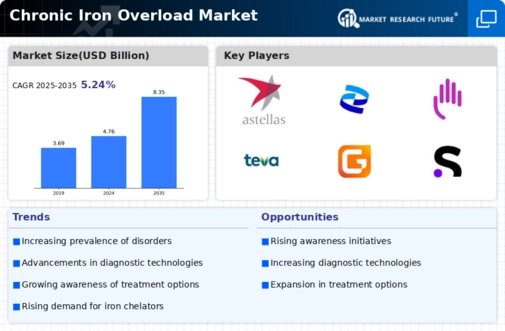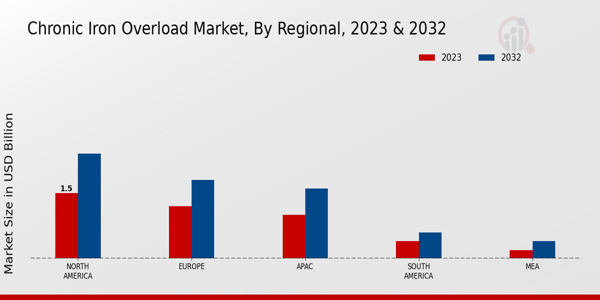Market Growth Projections
The Global Chronic Iron Overload Market Industry is projected to experience substantial growth in the coming years. With a market value of 4.76 USD Billion anticipated in 2024, the industry is expected to expand to 8.35 USD Billion by 2035. This growth trajectory reflects a compound annual growth rate (CAGR) of 5.24% from 2025 to 2035. Factors contributing to this growth include rising prevalence of iron overload disorders, advancements in treatment options, and increased awareness among healthcare professionals and patients alike. The market's expansion is indicative of a broader recognition of the need for effective management of chronic iron overload conditions.
Rising Prevalence of Hemochromatosis
The increasing incidence of hereditary hemochromatosis, a genetic disorder leading to chronic iron overload, is a pivotal driver for the Global Chronic Iron Overload Market Industry. It is estimated that approximately 1 in 200 individuals in the United States are affected by this condition. As awareness grows, more individuals are being diagnosed, which subsequently elevates the demand for effective treatment options. This trend is expected to contribute significantly to the market, with projections indicating a market value of 4.76 USD Billion in 2024. The rising prevalence of this disorder underscores the necessity for innovative therapies and management strategies in the Global Chronic Iron Overload Market Industry.
Advancements in Diagnostic Techniques
Technological advancements in diagnostic methodologies are transforming the landscape of the Global Chronic Iron Overload Market Industry. Enhanced imaging techniques, such as MRI and liver biopsy, allow for earlier and more accurate detection of iron overload conditions. These innovations not only facilitate timely intervention but also improve patient outcomes. As healthcare providers increasingly adopt these advanced diagnostic tools, the market is poised for growth. The integration of these technologies is likely to drive the market value to 8.35 USD Billion by 2035, reflecting a growing recognition of the importance of early diagnosis in managing chronic iron overload.
Growing Awareness and Education Initiatives
The rise in awareness and educational initiatives surrounding chronic iron overload conditions is significantly influencing the Global Chronic Iron Overload Market Industry. Organizations and healthcare providers are increasingly focusing on educating the public about the risks associated with iron overload, leading to earlier diagnosis and treatment. Campaigns aimed at increasing knowledge about conditions such as hemochromatosis and thalassemia are becoming more prevalent. This heightened awareness is likely to drive market growth, as more individuals seek medical advice and intervention, contributing to a projected CAGR of 5.24% from 2025 to 2035 in the Global Chronic Iron Overload Market Industry.
Increasing Demand for Iron Chelation Therapy
The rising demand for iron chelation therapy is a crucial factor propelling the Global Chronic Iron Overload Market Industry. Patients with chronic iron overload conditions often require chelation therapy to manage excess iron levels effectively. The availability of various chelation agents, such as Deferasirox and Deferoxamine, has expanded treatment options for healthcare providers. As the population of patients requiring these therapies continues to grow, the market is expected to expand correspondingly. This trend is indicative of a broader recognition of the need for effective management strategies in chronic iron overload, further solidifying the market's trajectory.
Regulatory Support for Treatment Innovations
Regulatory bodies are increasingly providing support for the development and approval of innovative treatments for chronic iron overload, which is a significant driver for the Global Chronic Iron Overload Market Industry. Initiatives aimed at expediting the approval process for new therapies can enhance market dynamics by bringing novel treatment options to patients more rapidly. This regulatory environment encourages pharmaceutical companies to invest in research and development, potentially leading to breakthroughs in treatment. As a result, the market is likely to experience robust growth, aligning with the anticipated increase in market value over the coming years.













